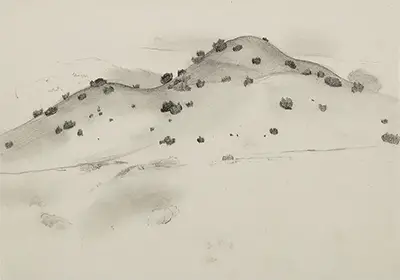Here we find two mounds in the distance. The environment appears dry and harsh, suggesting this is from the artist's time living in New Mexico. She was also resident in cities during her lifetime, but these seem a distant memory when browsing this landscape. There are a few hardy bushes that have managed to survive these conditions, which are dotted around the upper parts of the hills. O'Keeffe then inserts some areas of shading around the tips of the peaks in order to help us determine forms within this fairly plain artwork. In the foreground you will find very little detail at all, and this just helps to give us the impression of looking out across the landscape which the artist herself loved to do. She grew up in a fairly rural area herself and would glean inspiration for her work from all manner of different locations across the US as she moved around from time to time. We all know of her animal bone still life depictions as well, such as Rams Head Blue Morning Glory.
O'Keeffe adored the landscape around her and would regularly use items that she found lying around in the desert as subjects for her still life work. She exhibited several drawings early on in her career and this pricked the interest of a number of collectors who all sensed something special lurking within Georgia's mind. As she developed, they would be proven correct but it was only when she started to work with oils, specifically with bright tones, that the public showed interest. Today she is regarded as one of the most influential American artists of all time, regularly placed alongside the likes of Basquiat and Pollock in terms of contribution to modern art.
Another interesting artist to look at is Francisco de Goya who produced many stunning drawings during his own career. He was highly accomplished in portraiture and placed a great importance on being able to work with a variety of different mediums across his career. Goya was remembered most for two things, firstly his technical brilliance, and secondly his very unique approach which brought about a darkness and scary nature across many of his works. There were also periods within his extensive career in which he delivered brighter tones, and so it is hard to summarise his work with just a single artwork. The same can be said for O'Keeffe in that regard, and although her style was very different to Goya, she may well have studied the great masters in order to develop her own technical understanding as a young student, at which point she would not have known about the stylistic direction that she would later head. Goya's most famous painting perhaps remains The Clothed Maja.
